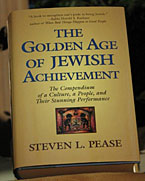Excerpt:
Visual Arts & Architecture©
"When. . . Chaim Soutine (1893-1943), the son of a poor hasidic tailor, painted a portrait, . . . his father flogged him. Chagall's father, who hauled herring barrels for a living, did not go so far when his son began to study with portraitist, Yehuda Pen, but he flung the five-rouble fee violently to the ground as a gesture of disapproval."
Paul Johnson, History of the Jews
Charles Murray's book, Human Accomplishment, lists the 479 great Western artists from 800 BC to 1950. They are not his selections, but consensus picks drawn from fifteen of the world's foremost art authorities, such as the thirty four volumes of J. Turner's 1996 Dictionary of Art, Encyclopedia Britannica, and thirteen more. Based on their coverage of the individual artists, Murray took the implied rankings and compiled them into a single comprehensive list of the Western artists who have mattered most.
The fact that sixteen Jewish artists are included among the 479 (3.3 percent) seems only mildly interesting since, in the years Jews made the list, Murray calculates they were 2.1 to 2.2 percent of the West's population. Their representation among great artists was thus only slightly higher than their percentage of the relevant population. But, accurate as that observation is, it misses a key point. The Jewish Golden Age is of recent origin. Only in the last 125 years or so have Jews emerged as important figures in visual art. But once they arrived on the scene, they quickly rose to prominence. That story begins in biblical times.
Exodus 20:4 and Deuteronomy 5:8 in the King James Bible include among the Ten Commandments the familiar "Thou shalt not make unto thee any graven image, or any likeness of anything that is in the heaven above or that is in the earth beneath, or that is in the water underneath the earth." More recent versions of the Jewish Bible slightly alter that text saying, "You shall not make for yourself a sculptured image, any likeness of what is in the heavens above, or on the earth below, or in the waters below the earth." Presumably, the Jewish Bible draws on more recent translations of Hebrew text than the 1611 King James version, and its prohibition of "sculptured" images seems to reduce the implication that the Bible proscribes drawn or painted images. Nonetheless, at different times and places, and at varying levels of intensity, that commandment's language has inhibited Jews from pursuing visual arts.
But it was not always interpreted that way. The Jews who remained in Babylonia after their sixth century exile made it into a cultural capital. They stimulated art in Jerusalem and later, appear to have influenced the Byzantine school of painting....
